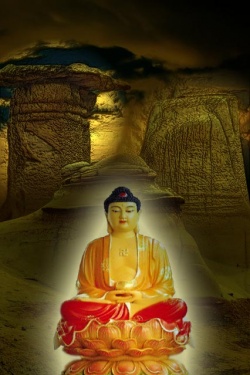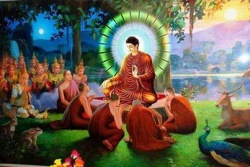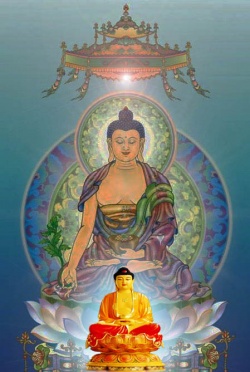The Svâbhâvakâya or Svâbhâvikakâya in Mahayana Teachings
By Jacques Mahnich on March 10, 2012 at 1:09 am
Most of the Tibetan Buddhism Schools have teachings about a svabhavakâya or svabhavikakâya, named either the third or fourth kâya, sometimes described as the sum of the other ones, sometimes as the basis for the other ones.
From « The Wish-Fulfilling Jewel : The Practice of Guru Yoga According to the Longchen Nyingthig Tradition (Rigdzin Jigme Lingpa)» :
« Receiving the Four Enpowerments – This fourth or word initiation is the introduction to the natural state of all phenomena ; through it we become a proper vessel for the practice of Dzogchen, the Great Perfection…
It is the ultimate buddhahood, the indivisibility of the three kayas, or the svabhavikakaya, the body of the true nature.
From « Mahamudra and related instructions – Core Teachings of the Kagyu Schools» :
The Svabhavakaya : This is great peace and is the nature of all phenomena. It is attained through the power of the dharmakaya, through realization.
The vajrayana calls this the body of great bliss (mahâsukhakâya) because its distinctive quality is supreme, unchanging bliss.
Ârya Nâgârjuna has said : « I pay homage to that which is free from the activity of the three realms ; which is the equality of space ; which is the nature of all things ;… Praise to the Three Kâyas (Kayâtrayastotra), Toh 1123, Tengyur, bstod tshogs,ka,70b3.
Other references to the svabhavakâya (from the same book) :
« The svabhavakâya is the dharmakaya of the tathâgatas, because it is the locus of power over everything.
» Asanga – Mâhâyanasamgraha, Toh 4048, Tengyur, sems tsam, ri, 37a4. The Tibetan adds the word « phenomena » to make « power over all phenomena »
« The categories of the kâyas of the buddhas : There is the svabhava, the samboghakâya, and the other kâya is the nirmânakâya.
The first is the basis for the other two. » Sûtrâlamkâra 10:60,11a7.
« The svabhavakâya is equal and subtle. » Sûtrâlamkâra 10:62,11b1. The Dergé Tengyur has « Rang bzhin sku ni mnyam pa dang »
« The first kâya (svabhavakaya) has the qualities of liberation, such as the powers and so on ». Sublime Continuum, 3:2,65b2
From Jamgön Kongtrul – The Treasury of Knowledge :
Talking about the results of practice : « The uncommon transformation is that the physical channels transform into the nirmanakaya, the channel syllabes into sambhogakaya, the constituent elixir into dharmakaya and great bliss, and the core energy current of pristine awareness transform into the svabhavikakâya. »
« … svabhavikakâya is characterized as emptiness, which is to say, the nature of all phenomena, a nature that is free of all elaboration and completely pure ; »
« There are four kayas when one adds the svabhâvikakâya (enlightened dimension of the very essence of being itself) of innate presence, or mahâsukhâya, to the three kayas.
3) Sakya Schools
From the Vajra Lines of the Path with the Results (Virupa) – Explication of the Treatise for Nyak :
« The naturally spontaneous, utterly pure svâbhâvikakâya essence body is achieved. The result is perfected. »
« The fourth initiation dissolves the pulsations of the vital winds…
The vital winds are transformed and ‘omnipresent enlightened body, speech, and mind, the svâbhâvikakâya essence body’, is actualized. »
These descriptions , root texts and commentaries are supporting the idea highlighted about the principle of svabhava in Mahayana Buddhism, as not relative to a permanent quality, but rather as an essence. It is often described as the nature of the phenomena, as a basis, never as eternal.



